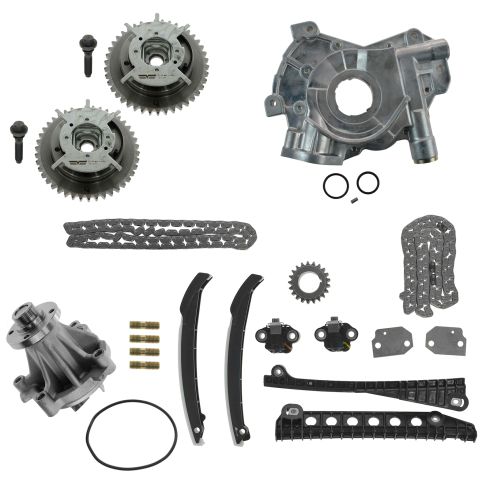1ATBK00175-Ford Lincoln Timing Chain Set with Water Pump DIY Solutions ETS00305

Replaces
2008 Ford F250 Super Duty Truck V8 5.4L with 30mm Hub Timing Chain Set with Water Pump DIY Solutions ETS00305

Product Reviews
Loading reviews
4.00/ 5.0
2
2 reviews
Great parts for the money
June 3, 2018
My truck runs awesome now. I gave it a four star just because the guides that came with the kit were not that great to work with. But on the other hand all the rest was quality parts. I did not use the oil pump that came with the kit I went with a melling oil pump.
[{"url": "https://wac.edgecastcdn.net/001A39/prod/media/pNISJll75W64CYGsite/0e799793a75c327274181ff125dca9a5_1712075223876_0.jpeg", "caption": ""}]
April 2, 2024
Good timing kit , truck running good for right now?..
Customer Q&A
Are these parts made in the USA?
March 26, 2017
10
We have a few different aftermarket companies build these parts specifically for us, as our 1A Auto house brand. They are manufactured to the same OEM specifications as the original part that came with your vehicle. These parts are made overseas. If you have any further questions, please don't hesitate to ask.
March 27, 2017
Tim K
Does this set fit an 04 Lincoln Navigator as it says in the description?
February 13, 2019
10
Thank you for your questions, but this will only fit 2005-2013 Navigators. Currently, we do not carry this part for your vehicle. We're always updating our inventory so please check back soon! If you have any other questions, let us know.
February 13, 2019
T I
Are all gaskets needed included?
December 24, 2019
10
Thank you for your inquiry. This kit will only include the gaskets for the water pump and the oil pump. If there are more gaskets that need to be replaced on your vehicle those would need to be purchased separately. Please let us know if you have any further questions.
December 26, 2019
A C
Are the cam phasers OEM Ford quality? Any problems? Any successes?
May 3, 2020
10
Thank you for your inquiry. These parts will be manufactured to exact OE specifications, and will fit and function just like the original parts that were on the vehicle. Please let us know if you have any further questions.
May 4, 2020
A C
Why is there 2 o rings and a tiny plastic piece with the oil pump? Where do they go?
September 19, 2020
10
Thanks for your inquiry. Written and video installation instructions are found on the product page under the "How-To & Tools" tab.
We're constantly adding new installation video instructions. If we do not have one for your vehicle on the product listing page, please check again at a later time or check our Video Library to see similar repairs here: https://www.1aauto.com/videos. Please let us know if you have any further questions.
September 19, 2020
Anthony C
Can I purchase this kit with the upgraded m340hv oil pump?
November 16, 2020
10
We would need your VIN number to see if we had any other pumps available for your specific vehicle.
November 16, 2020
Christa R
Is the oil pump that comes with the kit a high volume pump, if not ,you need the high volume pump for the 5.4, 4.6 and 6.8 modular motors?
November 16, 2020
Is the oil pump that comes with the kit a high volume pump, if not ,you need the high volume pump for the 5.4, 4.6 and 6.8 modular motors?
November 16, 2020
10
The parts in this kit are built to your vehicle's exact OEM specifications if your vehicle is listed in the fitment tab. Please be advised that this timing set is designed for the professional installer
November 17, 2020
Christa R
Is the oil pump that comes with the kit a high volume pump, if not ,you need the high volume pump for the 5.4, 4.6 and 6.8 modular motors?
November 16, 2020
10
We do apologize we do not have that specification. This kit is designed to replace the original equipment.
November 17, 2020
Corey M
Is the oil pump the new style high volume?
February 24, 2021
10
The parts in this kit are built to your vehicle's exact OEM specifications if your vehicle is listed in the fitment tab. Please be advised that this timing set is designed for the professional installer
February 24, 2021
Christa R
Does this kit include a crankshaft pulley bolt?
November 23, 2021
10
No it does not, what you see in the picture thats what you get
November 23, 2021
V A
10
The crankshaft pulley bolt is not included.
November 23, 2021
Jessica D
Ford is a registered trademark of Ford Motor Company. 1A Auto is not affiliated with or sponsored by Ford or Ford Motor Company.
See all trademarks.

















